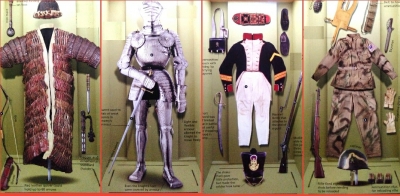
WAR
Throughout history, wars have broken out between tribes or nations over land, resources, and status. Methods of fighting changed over time, as people invented new, deadly weapons to fight with and improved ways of protecting soldiers from injury in battle.
BOW AND ARROW
The bow and arrow, invented more than 12,000 years ago, is one of the oldest weapons used in war. There are various types. The longbow was often used by foot soldiers, while this short Mongol bow is designed to be used from horseback.
ARMOUR
The earliest soldiers wore armour made from wood, leather, and bone. After people discovered how to work metals, soldiers could wear armour made of mail (interlocking metal rings) or metal plates.
SWORD
Swords are weapons for close combat (hand-to-hand fighting). They have a point for stabbing, and one or two sharp edges for slashing. A crossguard above the hilt (handle) prevents the user’s hand from sliding down onto the blade, and protects it from an enemy’s sword.
UNIFORM
In the confusion of battle, soldiers need to be able to tell friend from foe. Uniforms mark out which side a soldier belongs to and encourage discipline- soldiers wearing identical uniforms are more likely to act together as a group.
FIREARMS
Invented in China in the 14th century, firearms (portable guns) increased a soldier’s ability to kill his enemy from a distance. These weapons ended the age of the knight, whose expensive armour could offer little protection.
CAMOUFLAGE
In the 20th century, brightly coloured uniforms were replaced by clothes that helped soldiers blend in with their surroundings. Colours and patterns like the green and black stripes on this uniform are known as camouflage, from the French camoufler (to disguise).
Mongol archer In the 13th century, Mongol warriors from East Asia conquered the largest land empire in history. They fought on horses, using bows and arrows.
Medieval knight European knights saw warfare as a way to win honour. Knights wore expensive suits of armour to protect themselves and as a display of wealth.
French infantryman In the Napoleonic wars (1803–15), soldiers marched in ranks to the beat of a drum. At a signal, one line all fired their muskets.
US paratrooper In World War II, some soldiers attacked the enemy from the air. They leaped from aeroplanes wearing parachutes, landing behind enemy lines.
Picture Credit : Google




